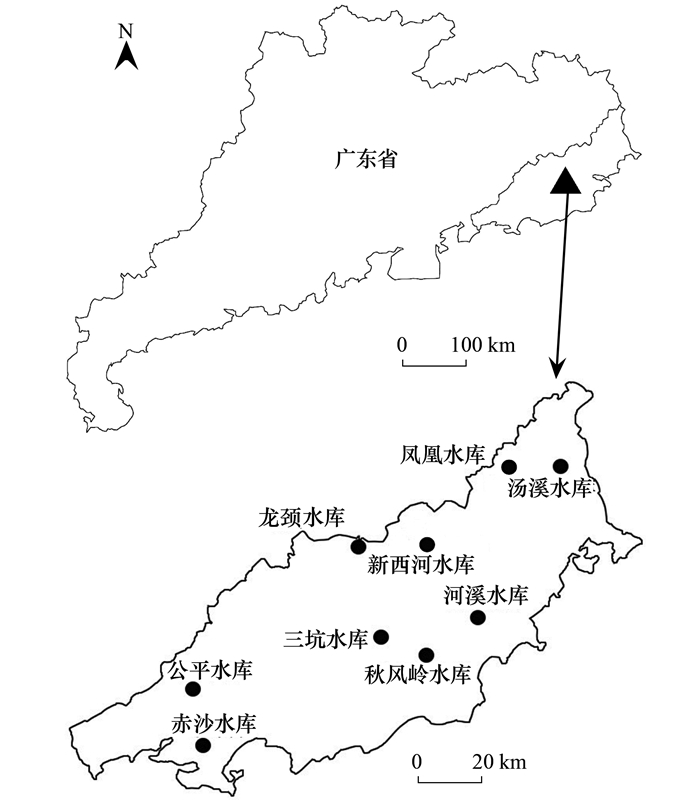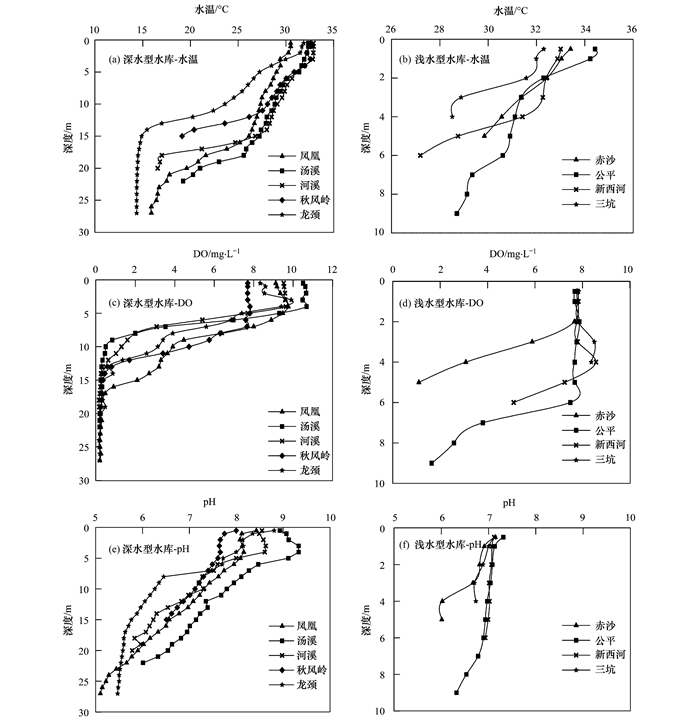2. 广东省水库蓝藻水华防治中心, 广州 510632;
3. 广东省水文局汕头水文分局, 汕头 515041
2. Guangdong Center for Control and Prevention of Reservoir Cyanobacterial Blooms, Guangzhou 510632, China;
3. Shantou Suboffice, Hydrological Bureau of Guangdong Province, Shantou 515041, China
Fe和Mn均是氧化还原敏感性元素, 在特定环境下, 其在水环境中能通过自身的价态转化及其与周围其他物质的相互作用来实现其地球化学循环[1~3].在氧化条件下, Fe、Mn易形成沉淀, 而在还原条件下以溶解态存在, 对水质有重要的影响, 例如, Fe及其化合物均为低毒和微毒性, 含Fe量高的水体呈黄色, 有铁腥味, 饮水中Fe含量较高会影响水的色度和嗅味; Mn盐毒性不大, 但Mn含量高的水体呈现黑色, 影响水的色度, 因此Fe和Mn是重要的水质评价指标之一[4~6].我国《地表水环境质量标准》(GB 3838-2002) 中规定集中式生活饮用水地表水源地Fe的项目标准限值为0.3mg·L-1, Mn的项目标准限值为0.1 mg·L-1[7].
Fe、Mn元素在地化循环中均为沉积型循环元素, 自然水体中Fe、Mn的来源主要有两种途径:地表径流的输入和沉积物释放[8].一般而言, 自然水体中Fe、Mn元素的浓度不高, 但在厌氧环境中, 沉积物的Fe、Mn释放增强可能导致水体中Fe、Mn浓度的升高, 尤其在高温、低pH值条件下, Fe、Mn的释放强度将显著增加[9~11].
我国南亚热带地区, 属于亚热带季风性气候区, 夏季高温, 水体易出现稳定分层以及底部溶解氧(DO)较低[12, 13].此外, 近年来, 随着人类活动的加剧, 该地区的水库面临越来越严重的富营养化问题, 而水体底部厌氧和酸化是水体富营养化的主要表征之一[14].南亚热带地区水库尤其是富营养水库, 夏季水体分层期间, 水体底部易出现厌氧可能导致Fe、Mn浓度较高.为验证该分布特点, 本文对广东省粤东地区9座不同深度和不同营养状态的水库夏季Fe、Mn的垂直分布进行了调查研究.
1 材料与方法 1.1 水库概况本次调查的粤东地区包括广东省汕头、揭阳、汕尾、潮州4市, 该地区水库水质相对于粤中、粤西等地区水库较好, 部分水库处在贫-中营养状态, 有利于本研究的开展, 因此本次调查选择该地区9座水库为研究对象. 9座水库均为当地主要的供水水源地或备用水源地(图 1).其中, 公平水库、龙颈水库和汤溪水库为大型水库, 其他6座水库为中型水库(表 1).

|
图 1 9座水库的分布示意 Fig. 1 Distribution of sampling reservoirs |
|
|
表 1 水库特征及使用现状 Table 1 Reservoir characteristics and function |
1.2 样品采集与分析
在水库坝前敞水区(供水区)深度最大的位置设置采样点, 于2016年7月25日至29日期间, 现场用多参数水质监测仪(YSI6600) 每隔1 m测定水温(T)、溶解氧浓度(DO)、pH值; 用塞氏盘测定透明度(SD); 测深仪测定水深.根据YIS测定的水体温度结构, 有明显温跃层(即1 m间隔的水层水温差异大于1℃)出现的水库定义为深水水库, 没有温跃层出现的水库为浅水水库.深水水库采集表层0.5 m, 温跃层和距底部1 m深度水层(底层)的水样; 浅水水库采集表层0.5 m和距底部1 m深度水层的水样.每层共采集2 L水样, 1 L用于测定总铁(TFe)、锰(TMn)和溶解态铁(DFe)、锰(DMn), 1 L用于测定总氮(TN)、总磷(TP)、氨氮(NH4+-N)和叶绿素a浓度, 其中Fe、Mn、TN、TP和NH4+-N根据国家水质监测标准方法进行测定[15].叶绿素a采用反复冻融浸提法测定[16].同时表层0.5 m和温跃层取样点的距底部深度(BD)的计算用水深减去取样深度(D).
1.3 数据处理采用单因素方差分析(One-Way ANOVA, LSD)比较了水层之间的Fe、Mn浓度的差异, 采用皮尔森相关性分析(Pearson)分析了Fe、Mn与N、P、深度(D)、距底部深度(BD)、DO、pH值等之间的相关性, 通过逐步线性回归模型分析了水库Fe、Mn浓度与其他因子的回归关系, 所有分析和作图均在SPSS 22.0、Sigmaplot 12.5中完成.
2 结果与分析 2.1 水体温度、DO浓度和pH值剖面特征凤凰、汤溪、河溪、秋风岭、龙颈这5座水库水深在16.3~34.1 m之间, 平均水深为(23.02±6.64) m, 有明显的温跃层, 为深水水库.它们在上层的0~4 m范围内水温下降缓慢, 为变温层; 4~20 m范围内水温出现跃变, 为温跃层; 而在20 m以下水温变化范围非常有限, 为均温层.表层DO浓度较高在7 mg·L-1以上, pH值在7.5以上; 温跃层DO浓度急剧下降, 降为1 mg·L-1左右; pH值也降到6以下; 底层DO浓度最低, 平均浓度为0.23 mg·L-1; pH均值为5.77; 3个水层的DO浓度、pH值均有显著差异(P<0.05), 见图 2.

|
图 2 水深大于10 m和水深小于10 m的水库水温(T)、溶解氧(DO)和pH值的垂直剖面特征 Fig. 2 Vertical profiles of water temperature (T), dissolved oxygen (DO) and pH in deep and shallow reservoirs |
赤沙、公平、新西河、三坑这4座水库深度较浅, 水深在4~9.5 m之间, 平均深度为(6.45±2.33) m, 水温降幅较小, 没有出现明显的温跃层, 基本处于混合状态, 属于浅水水库.表层DO浓度也在7 mg·L-1以上; pH值为7;底层DO浓度虽然有所下降, 但均值也超过4 mg·L-1; pH均值为6.5, 两个水层的DO浓度、pH浓度均无显著差异(P>0.05), 见图 2.
2.2 Fe、Mn浓度垂直分布特征在深水型水库中, 表层水体Fe、Mn含量较低, TFe、TMn平均浓度分别为0.054 mg·L-1、0.059 mg·L-1, DFe、DMn平均浓度分别为0.006 mg·L-1、0.031 mg·L-1; 在温跃层水体中Fe、Mn浓度升高, TFe、TMn平均浓度分别为0.117mg·L-1、0.096 mg·L-1, DFe、DMn平均浓度分别为0.051 mg·L-1、0.027 mg·L-1; 在底层水体中, 温度和DO都降到了最低, Fe、Mn平均浓度也最高, TFe、TMn平均浓度分别为0.399 mg·L-1、0.422 mg·L-1, DFe、DMn平均浓度分别为0.303 mg·L-1、0.326 mg·L-1.方差分析表明, 在深水型水库中底层水体Fe、Mn的平均浓度显著(P<0.05) 高于表层, 且TFe、TMn浓度分别是表层水体的7.4倍和7.1倍(图 3).

|
图 3 浅水水库和深水水库Fe、Mn浓度垂直分布特征 Fig. 3 Vertical distribution of Fe and Mn concentrations in deep and shallow reservoirs |
在浅水型水库中, 表层水体TFe、TMn平均浓度分别为0.093 mg·L-1、0.089 mg·L-1, DFe、DMn平均浓度分别为0.021 mg·L-1、0.029 mg·L-1; 底层水体TFe、TMn平均浓度分别为0.110 mg·L-1、0.089 mg·L-1, DFe、DMn平均浓度分别为0.022 mg·L-1、0.032 mg·L-1.随着水体深度的增加, Fe、Mn浓度并没出现明显的梯度变化, 底层水体Fe、Mn平均浓度与表层平均浓度并无显著性差异(P>0.05), 见图 3.
进一步方差分析结果表明:深水水库表层TFe、TMn、DFe、DMn与浅水水库表层TFe、TMn、DFe、DMn浓度并无显著性差异(P>0.05);而深水型水库底层TFe、TMn、DFe、DMn浓度显著高于浅水型水库底层TFe、TMn、DFe、DMn浓度(P<0.05).
2.3 Fe、Mn浓度与其他理化因子的关系在不区分两种水库类型的条件下, TFe、TMn、DFe、DMn浓度与其他因子的相关分析中均没有显著性.但在深水水库中TFe和DFe浓度与DO、pH和距底部深度均呈现显著负相关(P<0.05);与深度呈现极显著正相关(P<0.01).把TFe、TMn、DFe、DMn浓度与TN、TP作相关性分析显示, Fe、Mn与这几种营养盐均无显著相关性.浅水水库的TFe、TMn、DFe、DMn与DO、pH和距底部深度均呈负相关, 与深度呈正相关, 但所有相关关系均无显著性(表 2).
|
|
表 2 Fe、Mn浓度与环境因子间的Pearson相关性分析1) Table 2 Pearson correlation analysis between Fe and Mn concentrations and associated environmental variables |
pH值、DO浓度和距底部深度之间存在较大的共线性, 即pH值和DO浓度随距底部深度的降低而降低.多元逐步回归分析结果表明深度为决定TFe和DFe浓度的最重要的变量(表 3).
|
|
表 3 深水水库TFe和DFe与环境因子的多元逐步回归分析 Table 3 Multiple stepwise regression analysis between TFe and TMn concentrations and associated environmental variables in deep reservoirs |
3 讨论
在本次调查期间, 两类水库Fe、Mn垂直分布特征有着明显差异.从水体剖面看, 深水型水库垂直分布特征明显, TFe、TMn浓度从表层到底层依次上升, 且底层TFe、TMn浓度分别是表层的7.4和7.1倍; 而在浅水型水库中, 底层Fe、Mn浓度虽略高于表层但没有明显差异, 垂直分布特征不明显. Fe和Mn都是氧化还原敏感性元素, 极易受氧化还原环境的影响, 在含氧丰富的水体中, 三价Fe与氢氧根和磷酸根形成沉淀, Mn离子与氢氧根、碳酸根结合形成沉淀, 而在还原条件下, Fe、Mn被还原, 多以溶解态存在[17~20].本研究的结果表明调查区域的水库表层水体DO含量丰富(DO>8 mg·L-1), 有利于水体中的Fe、Mn形成沉淀往深水层迁移; 而10 m以下水层基本上处于缺氧条件, DO浓度低于1 mg·L-1, 有利于Fe、Mn被还原以溶解态存在, 该条件下, 不利于上层沉淀下来的Fe、Mn继续沉淀, 同时有利于沉积物中的Fe、Mn释放到水体中[21].本研究的结果也表明在深水水库中TFe和DFe的浓度与DO浓度、深度(D)和距底深度(BD)有着显著的相关性.进一步地, 在深水水库中, 底部高的Fe、Mn浓度主要以溶解态(占到总浓度的70%以上)存在.相对于浅水水库, 由于底层水体中DO相对较高(在1~6 mg·L-1之间), 即使靠近底部, 底层TFe和TMn浓度只是略高于表层水体, 但没有显著的差异, 因此推断, 深水水库底层高的Fe、Mn浓度是由于富氧的上层沉淀和厌氧条件下沉积物的释放共同导致的.
虽然在我国其他地区(陕西、江苏、贵州)的深水水库也得到类似的Fe浓度随水深增加而增加的结果[22~24](图 4).但将本研究结果与这些水库的同季节的研究结果相比较, 发现本文中水库Fe浓度远高于以上水库, 尤其是底层水体中的Fe浓度比以上水库底层(或上覆水)中的Fe浓度高1~2个数量级.

|
图 4 温带和其他亚热带地区水库总铁垂直分布特征[22~24] Fig. 4 Vertical distribution of total Fe concentration in temperate and other subtropical regions |
Fe、Mn以沉积型循环参与地球化学循环, 水体中的Fe、Mn浓度很大程度上受流域土壤状况的影响.我国北回归线以南是主要的红壤分布区, 红壤中Fe、Mn含量相对较高, 这可能是该地区水体中Fe、Mn浓度较高的重要原因[25].此外, 水体的DO浓度、pH值和温度对溶解性Fe、Mn的浓度有重要的作用, 高温、厌氧、酸性条件均有利于Fe、Mn以溶解态存在[11].广东省大部分地区位于北回归线以南, 常年高温, 大型水库大部分时期处于分层状态[12], 不利于大气复氧向深水层输送, 由于温度分层和水体富营养化, 深层水体常呈厌氧、酸性[26, 27].在这种高温、厌氧、酸性条件下, 有利于溶解性Fe、Mn以较高的浓度存在.因此, 根据我国南亚热带地区土壤类型和气候条件, 笔者推断, 流域内较高的Fe、Mn输入和高温及水体分层是导致该地区深水水库底层Fe、Mn浓度相对于其他地区水库更高的主要原因.
相关性分析表明, 只有深水水库TFe、DFe与DO浓度、pH值、深度和距底深度有显著相关性, TMn与DMn在两类水库中与其他变量均没有显著相关性, 这可能是由于自然界中Fe的化学活性(金属活动性)要强于Mn[28, 29].当外界环境条件发生变化时, 在相同时间内Fe的形态转化速率要高于Mn, 因此Fe比Mn要更为敏感, 与外界环境的相关性更为显著.进一步多元回归分析结果表明, 深度为决定TFe、DFe浓度的主要变量, 这更加确定了夏季在深水型水库中, Fe和Mn有着明显的垂直分布特征.
4 结论综上所述, 南亚热带地区, Fe、Mn浓度在水柱中存在明显的梯度分布, 水体的DO浓度、pH值和深度是影响Fe和Mn的浓度的重要因素, 水体稳定分层的深水水库底部厌氧和酸性条件有利于沉积物中Fe和Mn的释放, 是导致溶解性Fe和Mn浓度较高的重要原因.深水水库底层水体Fe、Mn浓度常高于我国《生活饮用水卫生标准》, 因此采取底层取水的供水方式存在较高的Fe、Mn超标风险.
致谢: 汕头水文分局的同事们在采样过程中提供帮助, 唐鹊辉、卓泉龙、韩诺和陈飞等在实验数据获取方面给予支持, 在此一并致谢.| [1] | Davison W. Iron and manganese in lakes[J]. Earth-Science Reviews, 1993, 34(2): 119-163. DOI:10.1016/0012-8252(93)90029-7 |
| [2] | Zaw M, Chiswell B. Iron and manganese dynamics in lake water[J]. Water Research, 1999, 33(8): 1900-1910. DOI:10.1016/S0043-1354(98)00360-1 |
| [3] | Taillefert M, Lienemann C P, Gaillard J F, et al. Speciation, reactivity, and cycling of Fe and Pb in a meromictic lake[J]. Geochimica et Cosmochimica Acta, 2000, 64(2): 169-183. DOI:10.1016/S0016-7037(99)00285-9 |
| [4] | 张超莹. 青岛王圈水库铁锰存在形态和释放规律的研究[D]. 青岛: 中国海洋大学, 2013. http://d.wanfangdata.com.cn/Thesis/D327073 |
| [5] | Gerke T L, Little B J, Maynard J B. Manganese deposition in drinking water distribution systems[J]. Science of the Total Environment, 2015, 541: 184-193. |
| [6] | Tobiason J E, Bazilio A, Goodwill J, et al. Manganese removal from drinking water sources[J]. Current Pollution Reports, 2016, 2(3): 168-177. DOI:10.1007/s40726-016-0036-2 |
| [7] |
GB 3838-2002地表水环境质量标准[S]. GB 3838-2002 Environmental quality standards for surface water[S]. |
| [8] | Czaplicka A, Bazan S, Szarek-Gwiazda E, et al. Spatial distribution of manganese and iron in sediments of the Czorsztyn Reservoir[J]. Environment Protection Engineering, 2016, 42(4): 179-188. |
| [9] | Foley B, Jones I D, Maberly S C, et al. Long-term changes in oxygen depletion in a small temperate lake:effects of climate change and eutrophication[J]. Freshwater Biology, 2012, 57(2): 278-289. DOI:10.1111/j.1365-2427.2011.02662.x |
| [10] |
刘树元, 郑晨, 袁琪, 等. 台州长潭水库铁锰质量浓度变化特征及其成因分析[J]. 环境科学, 2014, 35(10): 3702-3708. Liu S Y, Zheng C, Yuan Q, et al. Analysis on the variation characteristics of iron and manganese concentration and its genesis in Changtan Reservoir in Taizhou, Zhejiang Province[J]. Environmental Science, 2014, 35(10): 3702-3708. |
| [11] |
于海涛, 潘伟斌, 侯晓辉. 供水水库沉积物中铁锰的释放规律研究[J]. 工业安全与环保, 2012, 38(4): 72-75. Yu H T, Pan W B, Hou X H. Study on release of iron and manganese from sediments in a water-supply reservoir[J]. Industrial Safety and Environmental Protection, 2012, 38(4): 72-75. |
| [12] | 肖利娟. 华南地区两座大型水库浮游植物群落与演替机制比较[D]. 广州: 暨南大学, 2011. http://cdmd.cnki.com.cn/Article/CDMD-10559-1011129053.htm |
| [13] |
曾明正, 黄廷林, 邱晓鹏, 等. 我国北方温带水库——周村水库季节性热分层现象及其水质响应特性[J]. 环境科学, 2016, 37(4): 1337-1344. Zeng M Z, Huang T L, Qiu X P, et al. Seasonal stratification and the response of water quality of a temperate reservoir-Zhoucun Reservoir in north of China[J]. Environmental Science, 2016, 37(4): 1337-1344. |
| [14] |
邱晓鹏, 黄廷林, 曾明正. 溶解氧对湖库热分层和富营养化的响应——以枣庄周村水库为例[J]. 中国环境科学, 2016, 36(5): 1547-1553. Qiu X P, Huang T L, Zeng M Z. Responses of dissolved oxygen on thermal stratification and eutrophication in lakes and reservoirs-an example in Zhoucun Reservoir in Zaozhuang City[J]. China Environmental Science, 2016, 36(5): 1547-1553. |
| [15] | 国家环境保护总局. 水和废水监测分析方法[M]. 第四版. 北京: 中国环境科学出版社, 2002. |
| [16] |
林少君, 贺立静, 黄沛生, 等. 浮游植物中叶绿素a提取方法的比较与改进[J]. 生态科学, 2005, 24(1): 9-11. Lin S J, He L J, Huang P S, et al. Comparison and improvement on the extraction method for chlorophyll a in phytoplankton[J]. Ecologic Science, 2005, 24(1): 9-11. |
| [17] | Shaked Y, Erel Y, Sukenik A. The biogeochemical cycle of iron and associated elements in Lake Kinneret[J]. Geochimica et Cosmochimica Acta, 2004, 68(7): 1439-1451. DOI:10.1016/j.gca.2003.09.018 |
| [18] | 贾国东, 钟佐燊. 铁的环境地球化学综述[J]. 环境科学进展, 1999, 7(5): 74-84. |
| [19] | Neretin L N, Pohl C, Jost G, et al. Manganese cycling in the Gotland Deep, Baltic Sea[J]. Marine Chemistry, 2003, 82(3): 125-143. |
| [20] | Cerrato J M, Reyes L P, Alvarado C N, et al. Effect of PVC and iron materials on Mn(Ⅱ) deposition in drinking water distribution systems[J]. Water Research, 2006, 40(14): 2720-2726. DOI:10.1016/j.watres.2006.04.035 |
| [21] | Gantzer P A, Bryant L D, Little J C. Controlling soluble iron and manganese in a water-supply reservoir using hypolimnetic oxygenation[J]. Water Research, 2009, 43(5): 1285-1294. DOI:10.1016/j.watres.2008.12.019 |
| [22] |
马越, 郭庆林, 黄廷林, 等. 西安黑河金盆水库季节性热分层的水质响应特征[J]. 水利学报, 2013, 44(4): 406-415. Ma Y, Guo Q L, Huang T L, et al. Response characteristics of water quality to the seasonal thermal stratification in Jin-pen reservoir along the Heihe river, Xi'an city in China[J]. Journal of Hydraulic Engineering, 2013, 44(4): 406-415. |
| [23] |
朱维晃, 吴丰昌. 贵阳市阿哈湖水库中铁、锰的形态分布[J]. 中国环境科学, 2006, 26(S1): 83-86. Zhu W H, Wu F C. The speciation and distribution of iron and manganese in the A-Ha Lake, Guiyang City[J]. China Environmental Science, 2006, 26(S1): 83-86. |
| [24] | 杨晓红, 郑俊, 常艳春, 等. 中型水库水温分层的影响及分层取水建议[J]. 城镇供水, 2014(5): 62-66. |
| [25] | 龚子同. 中国土壤地理[M]. 北京: 科学出版社, 2014. |
| [26] | Obenour D R, Michalak A M, Zhou Y T, et al. Quantifying the impacts of stratification and nutrient loading on hypoxia in the northern Gulf of Mexico[J]. Environmental Science & Technology, 2012, 46(10): 5489-5496. |
| [27] |
张垒, 李秋华, 黄国佳, 等. 亚热带深水水库——龙滩水库季节性分层与富营养化特征分析[J]. 环境科学, 2015, 36(2): 438-447. Zhang L, Li Q H, Huang G J, et al. Seasonal stratification and eutrophication characteristics of a deep reservoir, Longtan Reservoir in subtropical area of China[J]. Environmental Science, 2015, 36(2): 438-447. |
| [28] | 陶亚奇, 马宏佳. 正确理解与探究金属活动性顺序[J]. 化学教育, 2003, 24(6): 36. |
| [29] |
汪福顺, 刘丛强, 梁小兵, 等. 铁锰在贵州阿哈湖沉积物中的分离[J]. 环境科学, 2005, 26(1): 135-140. Wang F S, Liu C Q, Liang X B, et al. Acid mining drainage impacts on the separation between iron and manganese in sediments of the Aha Lake, Guizhou Province[J]. Environmental Science, 2005, 26(1): 135-140. |
 2017, Vol. 38
2017, Vol. 38


